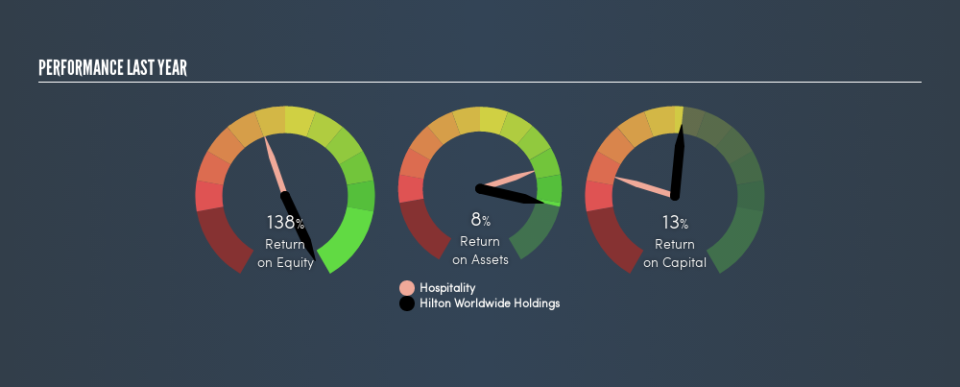What Can We Make Of Hilton Worldwide Holdings Inc.’s (NYSE:HLT) High Return On Capital?

Today we are going to look at Hilton Worldwide Holdings Inc. (NYSE:HLT) to see whether it might be an attractive investment prospect. To be precise, we'll consider its Return On Capital Employed (ROCE), as that will inform our view of the quality of the business.
First up, we'll look at what ROCE is and how we calculate it. Second, we'll look at its ROCE compared to similar companies. Last but not least, we'll look at what impact its current liabilities have on its ROCE.
Understanding Return On Capital Employed (ROCE)
ROCE is a metric for evaluating how much pre-tax income (in percentage terms) a company earns on the capital invested in its business. Generally speaking a higher ROCE is better. Ultimately, it is a useful but imperfect metric. Author Edwin Whiting says to be careful when comparing the ROCE of different businesses, since 'No two businesses are exactly alike.'
So, How Do We Calculate ROCE?
The formula for calculating the return on capital employed is:
Return on Capital Employed = Earnings Before Interest and Tax (EBIT) ÷ (Total Assets - Current Liabilities)
Or for Hilton Worldwide Holdings:
0.13 = US$1.4b ÷ (US$14b - US$2.6b) (Based on the trailing twelve months to December 2018.)
So, Hilton Worldwide Holdings has an ROCE of 13%.
View our latest analysis for Hilton Worldwide Holdings
Does Hilton Worldwide Holdings Have A Good ROCE?
One way to assess ROCE is to compare similar companies. Using our data, we find that Hilton Worldwide Holdings's ROCE is meaningfully better than the 10% average in the Hospitality industry. We consider this a positive sign, because it suggests it uses capital more efficiently than similar companies. Independently of how Hilton Worldwide Holdings compares to its industry, its ROCE in absolute terms appears decent, and the company may be worthy of closer investigation.
Our data shows that Hilton Worldwide Holdings currently has an ROCE of 13%, compared to its ROCE of 3.3% 3 years ago. This makes us wonder if the company is improving.
Remember that this metric is backwards looking - it shows what has happened in the past, and does not accurately predict the future. Companies in cyclical industries can be difficult to understand using ROCE, as returns typically look high during boom times, and low during busts. This is because ROCE only looks at one year, instead of considering returns across a whole cycle. Since the future is so important for investors, you should check out our free report on analyst forecasts for Hilton Worldwide Holdings.
What Are Current Liabilities, And How Do They Affect Hilton Worldwide Holdings's ROCE?
Current liabilities include invoices, such as supplier payments, short-term debt, or a tax bill, that need to be paid within 12 months. The ROCE equation subtracts current liabilities from capital employed, so a company with a lot of current liabilities appears to have less capital employed, and a higher ROCE than otherwise. To check the impact of this, we calculate if a company has high current liabilities relative to its total assets.
Hilton Worldwide Holdings has total assets of US$14b and current liabilities of US$2.6b. As a result, its current liabilities are equal to approximately 19% of its total assets. A fairly low level of current liabilities is not influencing the ROCE too much.
The Bottom Line On Hilton Worldwide Holdings's ROCE
With that in mind, Hilton Worldwide Holdings's ROCE appears pretty good. There might be better investments than Hilton Worldwide Holdings out there, but you will have to work hard to find them . These promising businesses with rapidly growing earnings might be right up your alley.
If you are like me, then you will not want to miss this free list of growing companies that insiders are buying.
We aim to bring you long-term focused research analysis driven by fundamental data. Note that our analysis may not factor in the latest price-sensitive company announcements or qualitative material.
If you spot an error that warrants correction, please contact the editor at editorial-team@simplywallst.com. This article by Simply Wall St is general in nature. It does not constitute a recommendation to buy or sell any stock, and does not take account of your objectives, or your financial situation. Simply Wall St has no position in the stocks mentioned. Thank you for reading.

